



Today, the pink pipes that network construction sites are the most visible reminders of Berlin's swampy origins, and our reliance on hydraulic engineering to build dams and drain fens, destroying peatland ecologies in our drive to colonize nature. »SWAMP THINGS!« invites those peatland ecologies to the BHROX pavilion–as haunting echoes of Berlin’s watery past, as fenland formed from glacial meltwaters.
Peatlands (fens, bogs, swamps, and marshes) cover just three percent of the Earth's surface, but when wet, they sequester twice as much carbon as all the biomass in the world’s forests combined. Rewetting peatlands is an urgent climate protection strategy that seeks to reverse centuries of peatland destruction around the world. Rewetting supports the nurturing of species of trees, grasses, flowers, mosses, berries, and animals that once flourished in these liquid landscapes, and the sustainable harvesting of crops that thrive in wet peatlands to support human livelihoods (known as ›paludiculture‹). How can we nurture these peaty ecologies once more, and use their plants with care?
Working with local grasses harvested from fenland in the Oberes Rhinluch in Brandenburg, the exhibition explores the lively potential of peatland plants as sensuous materials through basketry techniques, open-source coiling machines, and multimodal workshops. Design research and materials science are useful tools for experimenting with the potential of these new and restored biomaterials. This novel material-driven design approach explores the active material properties of these grasses as whole plants rather than shredded biomass, and develops ways of using their fibers to their full potential for as long as possible.
Through techniques such as coiled basketry, the fibrous properties of grasses can be manipulated into new architectural textile assemblages, creating abstract objects that spark the imagination, and, we hope, encourage lively conversations with our visitors!
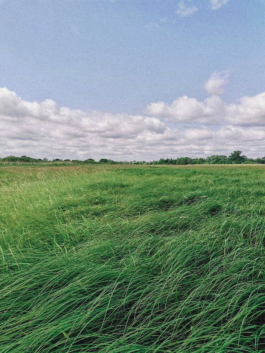


Picture credit: Charlett Wenig

Swamp Logic – Transforming Material Through Plant-Based Techniques
•
This project explores how plant structures can inform material transformation, drawing on the conceptual ground of »SWAMP THINGS!«. Through a biomimetic and interdisciplinary lens – bridging design, material studies, and botanical morphology – we investigate how the structural logic of plants can shape new, sustainable materials.
Rather than using plants as mere aesthetic inspiration, we study their anatomical features – gill formations, vascular structures, surface textures, and growth patterns – and translate these into material techniques like folding, layering, coiling, wrapping, and tensioning. These methods are guided by how plants function in their environments, not applied arbitrarily.
The result is a hybrid material language: expressive forms that blend natural logic with human intervention. This approach aligns with broader efforts to develop non-anthropocentric, ecologically attuned design practices.






Footwear prototypes and techniques experimentation. Concept: Evey Kwong and Charlett Wenig. Weaving and construction: Evey Kwong. Carpentry work: Lucas Schmidt.
Design through materiality, historical references, and craft technologies.
•
Our use of weaving and wood joinery techniques – rooted in tradition – brings a tactile depth to paludiculture materials like sedges and canary grass. Once treated as disposable biomass, these moisture-loving species are reimagined as durable, sensuous materials with real architectural and functional potential: from insulation to packaging.
In collaboration with Charlett Wenig, whose background in materials science complements a craft-based approach, we explored how fenland grasses behave, change, and settle into form. Coiled, twisted, and woven objects emerge not from a fixed plan, but from the responsive interplay between plant fibers and human touch.
Finally, the project draws a historical throughline, connecting the crafting of swamp shoes and clogs with today’s design challenges. Before the rubber boot, wooden-soled footwear protected people in wet, muddy terrain. We revisit this lineage through the lens of contemporary biomaterial exploration, asking: How can traditional techniques, ecological insight, and material curiosity help shape a more resilient, plant-driven design future?
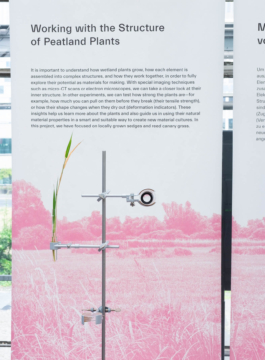
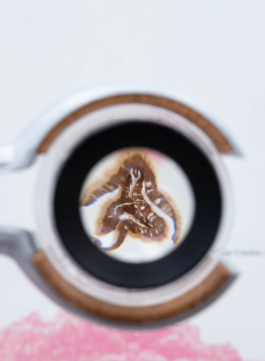
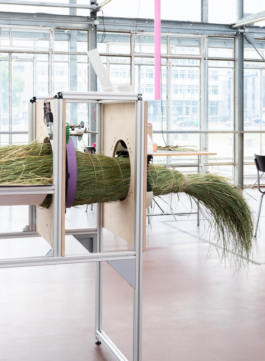
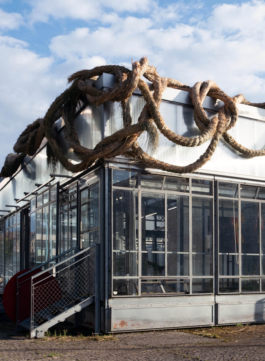
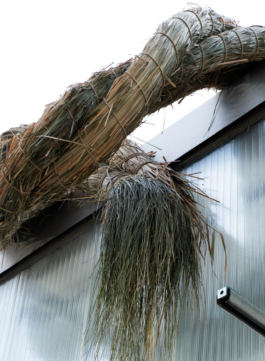
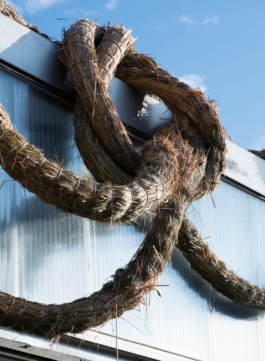

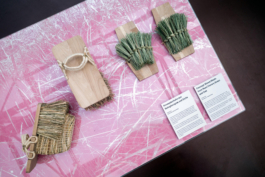
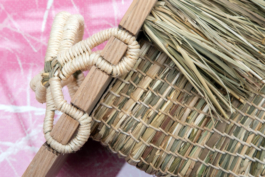
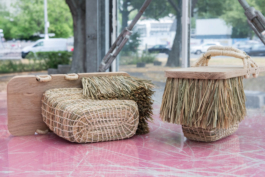
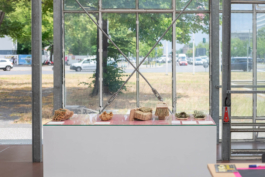
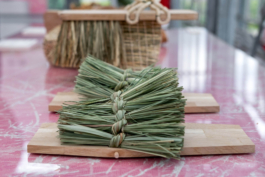
Impressions from »Swamp Things!« exhibition. Curation: Charlett Wenig and Lucy Norris.
Exhibition: 8–20 July 2025
Venue: BHROX bauhaus reuse
Ernst-Reuter-Platz
10587 Berlin
With contributions by: Janne Ebel, Swantje Furtak, Wulf Hein, Daniel Hengst, Cholena de Koningh, Evey Kwong & Jasmin Martinez
TEAM CREDITS:
Curation, Design, and Research: Charlett Wenig and Lucy Norris
Research Assistance: Kira Becker and Alena Stuhr
Research Collaboration: Ralf Pecenka
Project Management: Sophia Gräfe
Production Execution: Julia Blumenthal
Production Assistance: Mareen Baumeister, Marco Bott, Nick Geipel, Nicholas Plunkett, Tobias Schmidt, Jan von Szada-Borryszkowski, Tonja Wetzel and Laura ZorettoProject Management: Sophia Gräfe
Illustrations: Florian Weisz
Team BHROX bauhaus reuse: Robert K. Huber, Peter Winter, Adelina Nicolăescu, and Jiří Ferenc

Today, the pink pipes that network construction sites are the most visible reminders of Berlin's swampy origins, and our reliance on hydraulic engineering to build dams and drain fens, destroying peatland ecologies in our drive to colonize nature. »SWAMP THINGS!« invites those peatland ecologies to the BHROX pavilion–as haunting echoes of Berlin’s watery past, as fenland formed from glacial meltwaters.
Peatlands (fens, bogs, swamps, and marshes) cover just three percent of the Earth's surface, but when wet, they sequester twice as much carbon as all the biomass in the world’s forests combined. Rewetting peatlands is an urgent climate protection strategy that seeks to reverse centuries of peatland destruction around the world. Rewetting supports the nurturing of species of trees, grasses, flowers, mosses, berries, and animals that once flourished in these liquid landscapes, and the sustainable harvesting of crops that thrive in wet peatlands to support human livelihoods (known as ›paludiculture‹). How can we nurture these peaty ecologies once more, and use their plants with care?
Working with local grasses harvested from fenland in the Oberes Rhinluch in Brandenburg, the exhibition explores the lively potential of peatland plants as sensuous materials through basketry techniques, open-source coiling machines, and multimodal workshops. Design research and materials science are useful tools for experimenting with the potential of these new and restored biomaterials. This novel material-driven design approach explores the active material properties of these grasses as whole plants rather than shredded biomass, and develops ways of using their fibers to their full potential for as long as possible.
Through techniques such as coiled basketry, the fibrous properties of grasses can be manipulated into new architectural textile assemblages, creating abstract objects that spark the imagination, and, we hope, encourage lively conversations with our visitors!

Picture credit: Charlett Wenig
Swamp Logic – Transforming Material Through Plant-Based Techniques
•
The project explores how plant structures can inform material transformation, drawing on the conceptual ground of »SWAMP THINGS!«. Through a biomimetic and interdisciplinary lens – bridging design, material studies, and botanical morphology – we investigate how the structural logic of plants can shape new, sustainable materials.
Rather than using plants as mere aesthetic inspiration, we study their anatomical features – gill formations, vascular structures, surface textures, and growth patterns – and translate these into material techniques like folding, layering, coiling, wrapping, and tensioning. These methods are guided by how plants function in their environments, not applied arbitrarily.

Picture credit: Charlett Wenig

The result is a hybrid material language: expressive forms that blend natural logic with human intervention. This approach aligns with broader efforts to develop non-anthropocentric, ecologically attuned design practices.





Design through historical references, materiality, and craft technologies
•
Our use of weaving and wood joinery techniques – rooted in tradition – brings a tactile depth to paludiculture materials like sedges and canary grass. Once treated as disposable biomass, these moisture-loving species are reimagined as durable, sensuous materials with real architectural and functional potential: from insulation to packaging.
In collaboration with Charlett Wenig, whose background in materials science complements a craft-based approach, we explored how fenland grasses behave, change, and settle into form. Coiled, twisted, and woven objects emerge not from a fixed plan, but from the responsive interplay between plant fibers and human touch.
Finally, the project draws a historical throughline, connecting the crafting of swamp shoes and clogs with today’s design challenges. Before the rubber boot, wooden-soled footwear protected people in wet, muddy terrain. We revisit this lineage through the lens of contemporary biomaterial exploration, asking: How can traditional techniques, ecological insight, and material curiosity help shape a more resilient, plant-driven design future?

»Swamp Things!« was part of the _matter Festival 2025 of the Cluster of Excellence »Matters of Activity«.












Impressions from »Swamp Things!« exhibition.
Exhibition: 8–20 July 2025
Venue: BHROX bauhaus reuse
Ernst-Reuter-Platz
10587 Berlin
With contributions by: Janne Ebel, Swantje Furtak, Wulf Hein, Daniel Hengst, Cholena de Koningh, Evey Kwong & Jasmin Martinez
TEAM CREDITS:
Curation, Design, and Research: Charlett Wenig and Lucy Norris
Research Assistance: Kira Becker and Alena Stuhr
Research Collaboration: Ralf Pecenka
Project Management: Sophia Gräfe
Production Execution: Julia Blumenthal
Production Assistance: Mareen Baumeister, Marco Bott, Nick Geipel, Nicholas Plunkett, Tobias Schmidt, Jan von Szada-Borryszkowski, Tonja Wetzel and Laura ZorettoProject Management: Sophia Gräfe
Illustrations: Florian Weisz
Team BHROX bauhaus reuse: Robert K. Huber, Peter Winter, Adelina Nicolăescu, and Jiří Ferenc